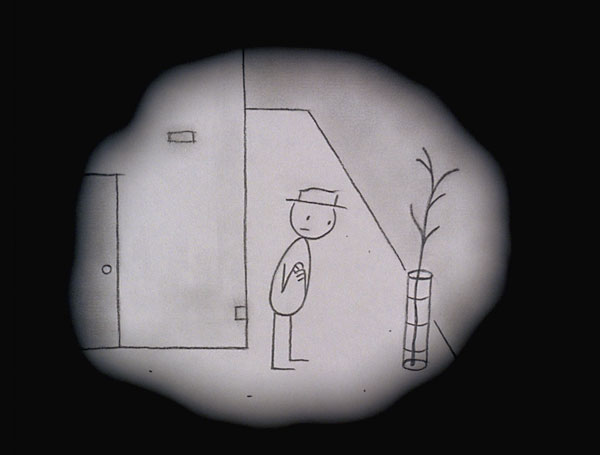It’s Such a Beautiful Day (Don Hertzfeldt 2011): USA
Reviewed by Jacqueline Kaden. Viewed at the Santa Barbara Film Festival.
 Don Hertzfeldt brings his disturbingly-funny style to a point of brilliance in his animated short, It’s Such A Beautiful Day. I must preface my review by saying that I am a die-hard Hertzfeldt fan and to see his work on the big screen was incredibly rewarding for me. However, what is interesting about this particular work is that anyone can appreciate it. Hertzfeldt’s work is somewhat (incredibly) dark and eluding, and for those who do not like dark humor, his work is not for them. What is unique about this short is that it is for everyone. In the theater, people from my age (19) up to somewhere in their 70’s were laughing, cringing, and sitting in awe of the main character Bill’s journey through the film. This piece is significant and would be a good starting place for anyone who is interested in becoming a fan of Hertzfeldt’s work.
Don Hertzfeldt brings his disturbingly-funny style to a point of brilliance in his animated short, It’s Such A Beautiful Day. I must preface my review by saying that I am a die-hard Hertzfeldt fan and to see his work on the big screen was incredibly rewarding for me. However, what is interesting about this particular work is that anyone can appreciate it. Hertzfeldt’s work is somewhat (incredibly) dark and eluding, and for those who do not like dark humor, his work is not for them. What is unique about this short is that it is for everyone. In the theater, people from my age (19) up to somewhere in their 70’s were laughing, cringing, and sitting in awe of the main character Bill’s journey through the film. This piece is significant and would be a good starting place for anyone who is interested in becoming a fan of Hertzfeldt’s work.
In this film, the viewer is introduced to a stick figure’s life and somewhat confusing battle with a mysterious case of memory loss and degrading memory. Bill’s life is shown to us through third person narration (voiced by Hertzfeldt himself). The viewer watches Bill under some kind of third person microscope, picking apart his brain injury, feelings, and confusion as the film is narrated. At some points in the film, the viewer is put into Bill’s view and very quickly, the viewer feels as though Bill is a part of them. The film continues on with dark humor in Bill’s inability to remember what he has done when he is released from a hospital to go home and rest. The humor peaks at a point where bill exits his apartment and notes, “It’s such a beautiful day.” He takes a walk and comes back to the outside of his apartment. This scene is repeated over and over and the viewer is able to find humor in this, despite the deeply touching and emotionally affecting disability Bill has. Soon, Bill’s condition worsens. He begins to forget more and more after renting a car and driving to see who we assume is his father, but Bill can’t remember. He drives and drives, unsure where he is going but desperate to find some meaning in the world that is rapidly degrading from his brain outward. Will Bill be able to survive whatever strange brain disease is causing his memory loss? Will he find meaning in the universe? Will we ever know why Bill is so special?
Hertzfeldt directs his efforts at ideas like memory, family relationships, existential crises, and basic relationships. Through Bill’s struggle to remember, the viewer too finds them self wondering if the world they live in is as concrete as they think, or if it is as pliable and nonsensical as Bill’s. Hertzfeldt brilliantly uses animation with mixed media and live-action shots to bring Bill and his world to life beyond the white paper he is drawn on. After the animation is finished, the viewer is left wondering, is my world more complete than Bill’s? Or is the world I live in as rapidly degrading as Bill’s?
About this entry
You’re currently reading “It’s Such a Beautiful Day (Don Hertzfeldt 2011): USA,” an entry on Student Film Reviews
- Published:
- 02.01.12 / 9am
- Category:
- Films, Santa Barbara Film Festival 2012
4 Comments
Jump to comment form | comments rss [?] | trackback uri [?]